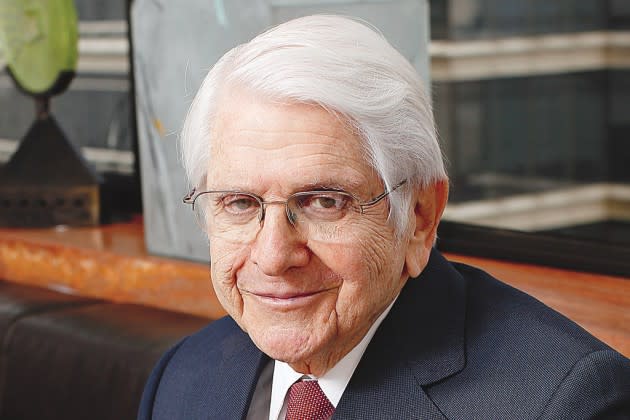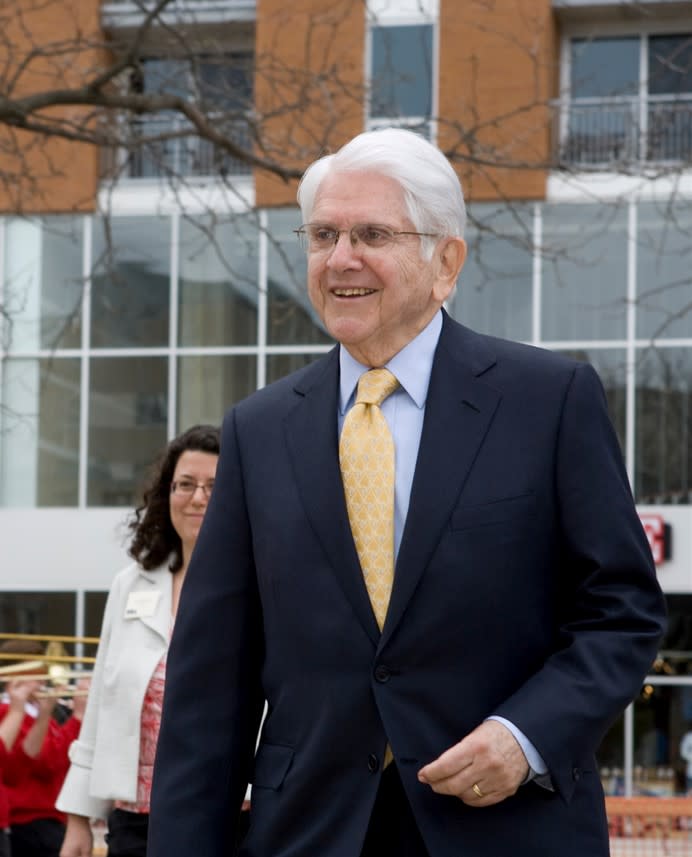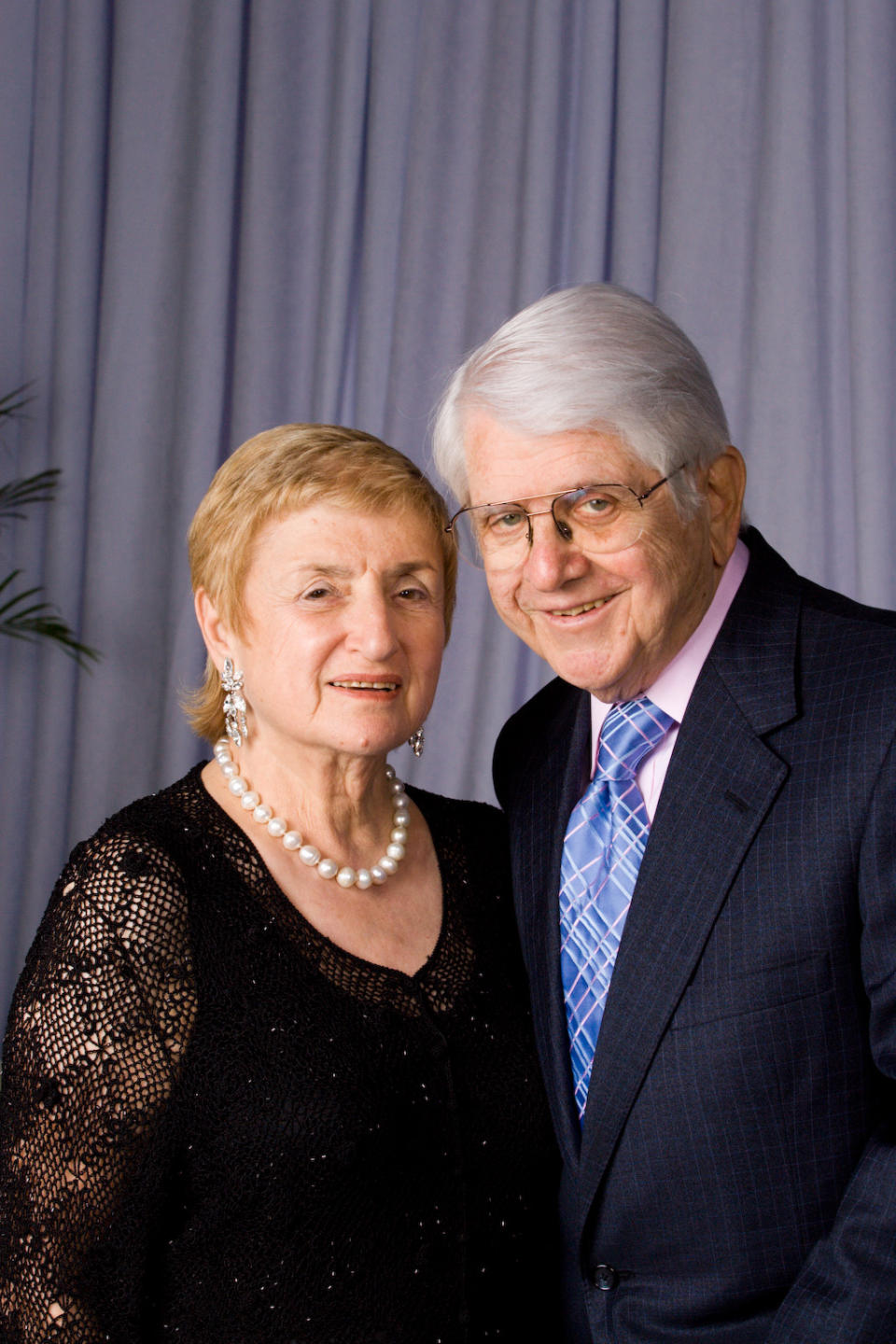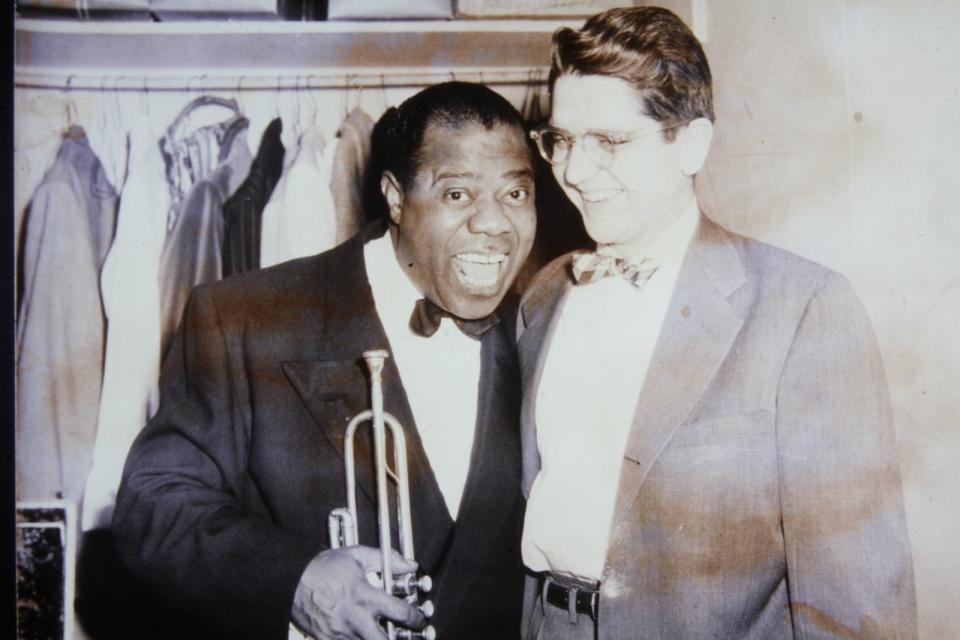Jerome Chazen, a Former Chairman and CEO of Liz Claiborne, Dies at 94
- Oops!Something went wrong.Please try again later.
- Oops!Something went wrong.Please try again later.

Jerome A. Chazen, Liz Claiborne’s former chief executive officer and chairman and one of the architects of the apparel giant’s phenomenal growth in the ’80s, died Sunday. He was 94.
He died at home of natural causes surrounded by his family, according to his son David.
More from WWD
Chazen spearheaded the sales, marketing, distribution and licensing programs that were a significant part of Claiborne’s success. He joined Claiborne in 1977, the year after it was founded by Liz Claiborne and her husband, Arthur Ortenberg, and Leonard Boxer. By 1989, Fortune magazine recognized the firm as the largest women’s apparel company in the U.S.
Born March 21, 1927 in New York City, Chazen served in the Navy in World War II and received a bachelor’s degree in economics from the University of Wisconsin-Madison, where he and Ortenberg met and were roommates. Chazen then went on to earn an MBA from Columbia Business School. He began his career as an analyst on Wall Street and spent the following 16 years in retailing, including 11 years at Winkelman’s prior to joining Claiborne.
Chazen previously said in interviews that he, Ortenberg and Claiborne in 1975 discussed the idea of forming Liz Claiborne, a plan that came to fruition in 1976. Chazen, who couldn’t immediately leave his job at that time, joined the following year.
The four founding partners divided up responsibilities. Chazen handled sales and marketing, Ortenberg focused on finance and operations, Claiborne focused on design and Boxer handled production. The company was able to offer value and prices that hadn’t been previously available in the U.S. by shifting production overseas.
After Claiborne and Ortenberg retired in 1989, Chazen was named chairman and CEO, and chairman emeritus in 1996. He was succeeded as chairman and ceo by Paul Charron.
Retailers and colleagues spoke highly of Chazen’s integrity and innovative initiatives.
Michael Gould, former chairman and chief executive officer of Bloomingdale’s, told WWD on Monday, “Jerry as a partner was always honorable. He was a man of his word.” Gould said he met Chazen in 1981 when Gould was at Robinsons. “We had Liz for personal appearances, and Jerry and I developed this incredible relationship. It was instantaneous friendship from 1981,” said Gould.
Gould said you meet people in life who are interesting, but what was unique about Chazen was he was interested in things – in travel, in jazz, what Gould’s kids were doing, his incredible glassware collection. He said they developed a phenomenal business at Robinson’s and later, Bloomingdale’s. Gould said he spoke to Chazen about two weeks ago. “He epitomized that you can do business with great integrity and build a business together,” said Gould.
Terry Lundgren, former chairman and ceo of Macy’s, Inc., said, “I knew him well. Jerry was a very powerful figure in the moderately-price apparel business. He was one of the first to source overseas in a major way, and the first to talk about in-store shops. He was really innovative along those lines. These [in-store shops] are common today, but they were not common then. He made his products stand out. He had a major presence at department stores across the country. Ralph Lauren wasn’t in this yet.”
William Dillard, II, chief executive officer of Dillard’s, said, “Jerry Chazen was a legend in the American apparel business. He helped change the landscape of fashion apparel retailing in the ’80s with accessible designer fashion. More importantly, he was a man of his word, and that trust allowed not only a great business partnership but also a lasting friendship. He was a great man and a true friend.”
Throughout his time at Claiborne, Chazen was widely praised for his strong marketing skills and his solid relationships with department stores. He was also a pioneer in developing international sourcing strategies in the early Eighties and oversaw the company’s retail concepts. Chazen also brought the company into the moderate market by way of acquisition.

courtesy shot.
Upon Chazen’s retirement in 1996, Jay Margolis, a former vice chairman of Claiborne, told WWD, “He’s done incredible things. He built an incredible franchise, along with Art [Ortenberg] and Liz [Claiborne].” Margolis said that Chazen brought a “door-by-door valuation” to Claiborne, which had only been done by the fragrance business. “He would study north, south and tropical levels, and was so consumer-dedicated,” Margolis said. “He would always try to fine-tune how a Liz Claiborne assortment should go out to that store and that particular door.”
On Monday, Margolis told WWD, “All through the late 70s, 80s and 90s, there was no better company than Liz Claiborne. It was just an amazing company. Jerry was the key to distribution, and Art and Liz were the vision.” Although Claiborne, Ortenberg and Chazen had their differences, Margolis said Chazen was instrumental in building up the store side.
“I liked Jerry. He was a good man, has an amazing family and was a terrific person. He lived a great life. He was so philanthropic in what he did for museums. His home had the most amazing modern art collection,” added Margolis.
Dana Buchman, who was a designer at Liz Claiborne and had her own label there, said, “I knew him for 40 years. I was design and he was sales. I was struck in the beginning of what a warm and generous personality he had. There was an energy to Jerry that was mesmerizing. We would have these intense design flow meetings and would choose the styles we would run. He managed to keep a genial energy. The guy was brilliant.”
She said Chazen would get feedback every week by style of what sold and it was all data driven. He would hear every Monday morning what sold the week before and he he was informed by this real data He would offer this information and express his point of view, without putting the kibosh on design.
“He was also a wizard with retailers,” she added. He would have these parties at the Copacabana for retailers which were “very glamorous and it was very un-Liz.” She said Claiborne didn’t do p.r., and he’d host a party that was welcoming and fun. She also noted how philanthropic and generous he was, and even into his Nineties, he’d been attending and contributing his time and ideas to foundation meetings.
Carol Hochman, who was president of the fashion accessories division at Liz Claiborne, said, “I stayed close with Jerry all these years. He was a remarkable man, and he didn’t get the credit he deserved for the success of Liz Claiborne. He was one of the best marketing and sales executives ever. He created the concept of assortment planning for doors which not only helped Liz Claiborne’s business, but also helped the retailer.”
“He had immense integrity and was a great parter for the stores,” she added. “They felt they had a real partnership when dealing with Jerry, and not just a salesman. His contributions to the success of Liz Claiborne can not be emphasized enough.”
Chazen, who watched the company grow from $7 million when he joined to more than $2 billion in revenues, attributed part of Liz Claiborne’s initial success to good timing.
“We entered the market at a time of exploding shopping centers and just at a time when women were entering the workforce,” Chazen said in 1996. “We were at the right time and the right place.
“We pioneered the concept of collection in the nondesigner market,” Chazen said. “At first, department stores didn’t know what to do with us. We were clearly sailing in unchartered waters…but fortunately, consumers saw the merchandise and it struck a chord.”
These were the days when Claiborne could count as many as 120 separate department store accounts. When he retired, it had shrunk to less than 20 as the department store underwent massive consolidation.
Chazen also admitted that the company made plenty of mistakes, such as the time it banked too much on terry cloth fashions in the late ’70s. “It was supposed to be really big, and we had all these expectations,” Chazen said. “But suddenly, the consumer just stopped buying them and we were stuck with all this merchandise.”
Another mishap that occurred in the late ’70s when the bulk of the company’s line was discolored in the warehouse.
“We tried this new fabric and it faded under the fluorescent lights in the warehouse. We were supposed to sell the jackets at $60, but ended up dumping them at a dollar each at discount stores. It almost put us out of business,” Chazen said.
There was also the problem with offering short hemlines in the ’80s, which Claiborne thought would go over well with the more traditional consumer. The consumer snubbed the look. “The only options for women who didn’t like the short skirts was the pants,” Chazen said.
Chazen said in a 1996 interview that the most difficult time was when Claiborne and Ortenberg retired from the company. “It was precisely at the same time all the retail consolidation started to happen. It was very different to separate what was happening from the outside.”
Chazen felt that the company should have gotten into the moderate business sooner. The company acquired some moderate labels, Russ Togs, Villager and Crazy Horse in 1992, but the category had been floundering.
At the time Chazen stepped down, the company was facing heavy competition from brands such as Tommy Hilfiger, Nautica and Ralph Lauren all launching lines targeted at the same customer. Chazen felt the new competition would have a positive effect and would increase traffic at department stores.
“The fashion industry has never been easy,” Chazen said in 1996. “It has always been fraught with companies that think they have a good idea and try it, and it doesn’t work and they go out of business.”
He felt that the difference at that time was that with increased centralized buying, retailers couldn’t afford to gamble on smaller companies and they had to work with the ones that were financially secure.
In an interview in 2006, Chazen told WWD, “When we started our company, the failure rate was 90 percent. It was the same as opening a restaurant or a Broadway show. Looking back, maybe it was easier than what it is today, but it was never easy. I knew we would be right because of the background of the principals of the company.”
In the decade between 1984 and 1994, the Liz Claiborne brand was the single largest supplier for department stores, according to Chazen, who noted that back then, retailers knew their lives depended on selling merchandise at regular price.
One of the more exciting times for Claiborne was the decision to go public, Chazen told WWD in 2006. The buzz surrounding the company generated much interest in the still relatively young firm.
According to Chazen, the company got lucky when a young banker at Merrill Lynch — who didn’t know much about apparel and consequently didn’t have a typical ingrown bias against fashion firms — helped Claiborne with its initial public offering.
In June 1981, Liz Claiborne went public, priced at $19 a share. According to Chazen, the company, “for more than 10 years, occupied the number-one slot for most successful IPO in the history of Merrill Lynch.”
Liz Claiborne died in 2007, Boxer died in 2009 and Ortenberg passed away in 2014.
Paul Charron, who succeeded Chazen as chairman and ceo of Claiborne, in 1994, said Monday, ” I think Jerry was a real leader in the growing American apparel business. He and his partners created a company that in its time was a juggernaut. Jerry was smart, extremely diligent and charismatic and he left me a branded and financial platform that we could built upon to help us realize its full potential.” The business grew to $2 billion under Chazen, Ortenberg and Boxer, and under Charron, it became a $5 billion corporation, acquiring brands such as Juicy Couture, Sigrid Olsen, Lucky Jeans and Kate Spade.
In addition, Charron noted that Chazen “was so incredibly philanthropic and had so many interests.”
“He was very curious and blessed that he had the money to make an impact in so many areas. He was a curious and interested man,” said Charron, calling him “a lion in the industry.”
John Pomerantz, former chairman and ceo of Leslie Fay Cos., Inc., said Monday, “I’ve always had a lot of respect for Jerry. He was a very strong competitor, but very honest and fair and did a great job with Liz Claiborne. To compete with Liz Claiborne in those days was very hard to do; but I know he had a great respect for Leslie Fay also. We could always count on Jerry to be a generous participant in the philanthropic efforts for the industry and the greater community. He will be missed.”
In 2012, Chazen wrote a book entitled “My Life at Liz Claiborne: How We Broke the Rules and Built the Largest Fashion Company in the World” (AuthorHouse). In it, Chazen described how the partners took a small start-up fashion business and propelled it into the Fortune 500. Chazen wrote that he believed that he hadn’t always gotten the public recognition or credit for building Liz Claiborne into the powerhouse that it was, since the perception was always that the company was run as a husband-and-wife operation by Liz Claiborne and Art Ortenberg. But the 84-year-old Chazen wrote that he liked to think of it as being “Liz’s and Jerry’s.”
People who worked at Claiborne during that time didn’t necessarily agree with that claim.
“Art always had difficulty giving me credit for the key role I played in the company. I had to live with that reality then and for many years after, no matter how my ideas and my management guided the company to success. I guess that I was having so much fun it didn’t really matter. But, to be honest, sometimes it did get to me,” Chazen wrote.
Internal struggles and tensions notwithstanding, Chazen described how he set out to break the rules of retailing to build a major company, which, by the time he left in 1996, was generating more than $2 billion in revenues.
Once he left Claiborne, he was often asked what he thought about the turn of events as the brand gradually withered and lost its appeal. “All I can say is it’s obvious the years have not been kind to Liz Claiborne. The company has changed dramatically and, unfortunately, not for the better,” Chazen said. After he retired, he continued to serve on the board of the Liz Claiborne Foundation, the philanthropic arm. Today, Liz Claiborne is now known as Kate Spade & Co., part of Tapestry, Inc.
In 1991, Chazen founded the Jerome A. Chazen Institute of Global Business at his alma mater, Columbia Business School. In addition to promoting academic research and symposia, the institute has given the opportunity to hundreds of students to work and study internationally as part of their MBA studies.
In May 2018, Chazen received an honorary Doctorate of Humane Letters from the University of Wisconsin-Madison in recognition of a career comprised of extraordinary accomplishments.
Chazen and his wife Simona, a practicing psychotherapist, along with their children, created the Chazen Foundation to support causes they were passionate about, including the University of Wisconsin, Columbia Business School, The Metropolitan Opera, the Museum of Arts and Design, The Louis Armstrong House & Archives, the Lupus Research Alliance, among many other social causes.
In 2003, Jerry and Simona Chazen, along with John Wiley, the chancellor of the University of Wisconsin, worked together to expand the existing university art museum with a new building that was more than double the size. The museum opened in 2009 and was renamed The Chazen Museum of Art. The Chazens also agreed to leave the vast bulk of their world-class collection to the museum.

Michael Mowery
The couple, who met at the University of Wisconsin and were married 72 years, had a lifelong love affair with jazz music, especially Louis Armstrong. Chazen had been a critical supporter and helped preserve Armstrong’s original Queens home and through the House Museum preserved the cultural, historical and humanitarian legacy of the jazz great.

courtesy shot of Chazen family
The Chazens were also early champions of the American Craft movement, and have supported the American Craft Museum for many years, through its transition to today’s Museum of Arts and Design. As board chair, Chazen was the leader of a successful effort to move the Museum to its current home at Columbus Circle in New York, successfully navigating many landmarks related issues and helping to redefine the Columbus Circle neighborhood.
Chazen’s son, David, spoke about his father being a leader until the very end.
“Our dad was always bigger than life to us, even godlike. My sisters and I all wanted his approval, to the very end. And we could always get it, if we could convincingly make our case. My father had the great gift of listening. Whether it was a family member, a business associate, a friend (or more likely a child of a friend) looking for advice, he was clearly more interested in learning about them rather than talking about himself.
“Those who knew him and business and philanthropy knew the exact same person his family knew. He ran everything – very well, thank you, and I can tell you that his children, probably like others in his life, were very happy to report to him.”
“My father was in control and relevant until the end, whether talking about politics, culture, business or even blockchain, he was smart, well versed, and up to date. A great model for his children.”
In addition to his wife Simona and son David, Chazen is survived by children, Kathy Chazen (who is married to Larry Miller) and Louise Chazen Banon (husband Sidney) and seven grandchildren and a great-grandson.
Services will be held Feb. 8 at 9:30 a.m. at Riverside Memorial Chapel at 180 West 76th Street in Manhattan.
Sign up for WWD's Newsletter. For the latest news, follow us on Twitter, Facebook, and Instagram.

